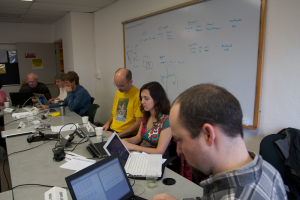 An important part of BIEN's mission of promoting global-scale research on plant distribution and function is to develop tools for merging and standardizing data. A principal goal of BIEN is to model geographic distributions and estimate range sizes for the majority of New World plant species, using specimen collections, ecological inventories and regional checklists as inputs. This challenge has lead to the development of ground breaking informatics solutions including:
An important part of BIEN's mission of promoting global-scale research on plant distribution and function is to develop tools for merging and standardizing data. A principal goal of BIEN is to model geographic distributions and estimate range sizes for the majority of New World plant species, using specimen collections, ecological inventories and regional checklists as inputs. This challenge has lead to the development of ground breaking informatics solutions including:
- The Taxonomic Name Resolution Service – Standardize your plant names here using the TNRS web site or here using the TNRS R package. The TNRS is a critical tool for integration of any botanical data. Click here for the TNRS publication. Nature featured the TNRS in a News & Views story. New sources are being added to the TNRS so stay tuned for more updates. Several algorithms underlie the TNRS and you can read more about them here.
- The Geographic Name Resolution Service – like the TNRS but for geographic names. Standardize your geographic names and locations here. The GNRS corrects and standardizes political division names according to the standards of the GeoNames database. Standardization of country, state and county names is the crucial first step in validating the accuracy of geocoordinates ("geovalidation"). BIEN geovalidations include checking that the coordinates of an observation fall within the boundaries of its declared political divisions.
- Native Species Resolver – This specimen record of Cattleya skinneri in Peru, is it native or introduced? Ask the NSR! Currently, the NSR can be accessed via a web service and in batch mode (shell access to server required).
- Novel tools, approaches, and computational algorithms for geographic validation, and range modeling using high-performance parallel computing. These data products are already forming the basis of several manuscripts submitted or in preparation and will ultimately be made publicly available.
- Plant-O-Matic – Plants for the people! A free mobile phone app for iPhone, Plant-O-Matic uses the GPS of the users phone to generate a personalized species list of all plant species that are found nearby. The app accesses the ~ 100,000 plant ranges in the New World to allow the user to explore the taxonomic, functional diversity around them. It provides links to images and additional information regarding each species. Read more about Plant-O-Matic in the publication. Download the app here.
- Veg-X, A new vegetation data exchange standard for botanical data, click here and here to learn more.
- BIEN 3 database schema – a flexible and comprehensive database to house, access, and discover botanical data. BIEN 3 is a completely new database for botany rebuilt from the ground up. The BIEN 3 schema (click here) is based in part on VegBank, with modifications to support herbarium specimens, a broader diversity of inventory data, and plant traits. Data is transferred to VegBIEN from specimen databases using the existing Darwin Core (DwC) exchange schema; plot data is transferred using VegCSV, a new plain text schema developed in the BIEN database supbgroup and based on the VegX vegetation exchange schema. Individual data sources—or the entire database—can be loaded and re-loaded rapidly, allowing ongoing updates as existing data sources are modified or grow, or new sources are acquired.
- BIEN 4 database schema. The BIEN 4 database schema feature keys improvements to the analytical tables and views accessed by BIEN users via the RBIEN R package (see below). The BIEN analytical tables are optimized for faster read access, support more extensive data validations and provide richer metadata on data sources, methodology and quality.
- R BIEN – Tools for Accessing the Botanical Ecology and Information Network Database – new release! R package to access BIEN data and data products including geographic ranges, phylogenies, traits, species lists, and plots. Query data based on either geography, phylogeny, or taxonomy.
- biendata.org – A simple geospatial portal to view and download species-level BIEN data. Just start typing the name of the species you are interested in. Hit return to then see the observation points and the associated geographic range map. Click the download data button to access geographic ranges, trait data, and observation data.
- R VegX. Developed by Miquel De Cáceres, Sebastian Schmidtlein and Susan Wiser, the R package VegX helps users get import, integrate, harmonize and export their vegetation data using the Veg-X standard. R VegX allows you to harness the power and flexibility of the VegX Exchange Schema while working within the familiar R programming environment. No knowledge of XML required!
